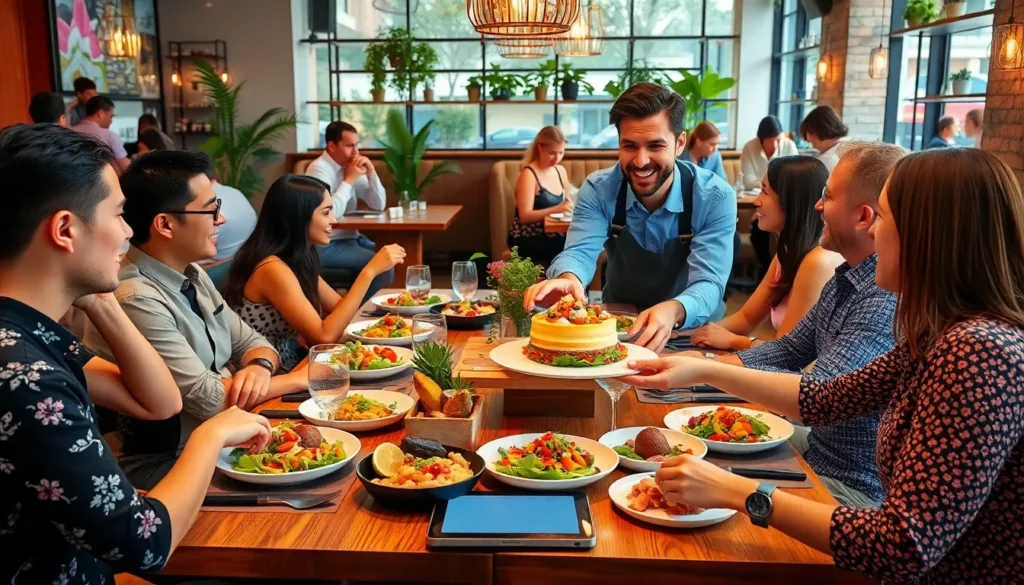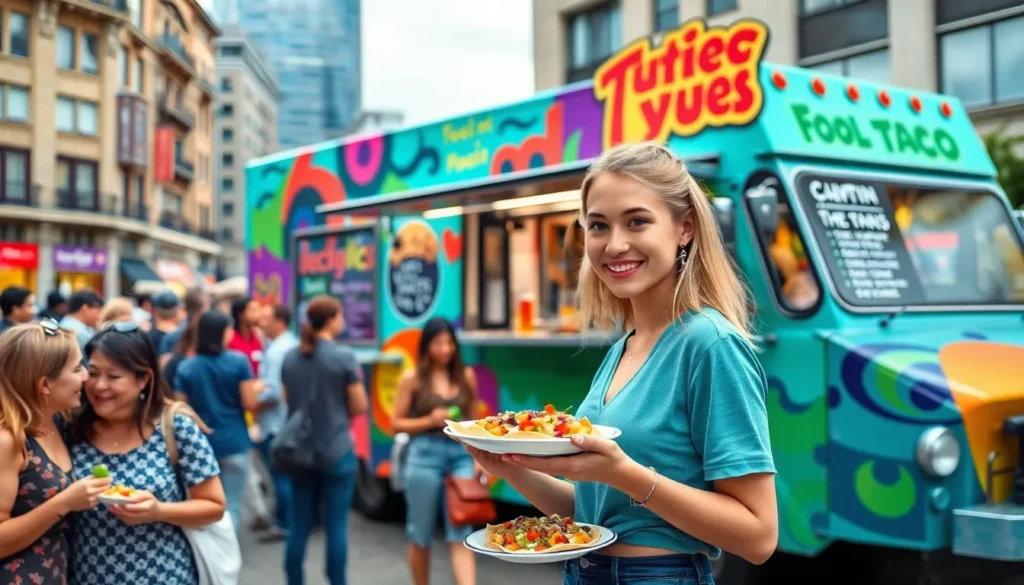In a world where first impressions matter, food packaging is the unsung hero of the culinary universe. It’s not just about keeping food fresh; it’s a creative canvas that tells a brand’s story. With consumers becoming increasingly eco-conscious and design-savvy, food packaging trends are evolving faster than a chef can whip up a gourmet meal.
Table of Contents
ToggleOverview of Food Packaging Trends
Food packaging trends reflect evolving consumer preferences and environmental considerations. Sustainability has taken center stage, leading brands to adopt biodegradable and recyclable materials. Numerous companies now prefer plant-based packaging options, which minimize reliance on plastics.
Design innovation plays a vital role in packaging strategies. Attractive and functional designs capture attention on store shelves, enhancing consumer engagement. Brands often utilize unique shapes and bold colors to stand out in competitive markets.
Transparency in packaging is gaining traction. Shoppers increasingly seek information about product ingredients and sourcing. Clear labeling fosters trust between consumers and brands, encouraging informed purchasing decisions.
Convenience also influences packaging trends. Easy-to-open packages and portioned servings make it simpler for consumers to enjoy their favorite foods. Many manufacturers design packaging with on-the-go lifestyles in mind, promoting accessibility and usability.
Health-conscious consumers contribute to another emerging trend. Packaging that highlights nutritional benefits resonates with shoppers looking for healthier options. Eye-catching claims such as “low-calorie” or “organic” often drive purchasing behavior.
Technological advancements are shaping the future of food packaging. Smart packaging, which incorporates IoT technology, improves food safety and enhances traceability. RFID tags and QR codes provide consumers with real-time information about freshness and origin.
Adopting eco-friendly practices has shifted expectations within the industry. Brands prioritize environmental impact, contributing to reduced waste in the supply chain. Suppliers emphasize sustainable sourcing and production methods to meet these demands.
Sustainable Packaging Solutions

Sustainable packaging is becoming essential in the food industry. Brands are increasingly choosing materials that lessen environmental impact.
Biodegradable Materials
Biodegradable materials break down naturally, reducing landfill waste. These options often include plant-based components, such as bioplastics made from corn starch or sugarcane. Many brands now utilize these materials to provide eco-friendly alternatives to traditional plastics. Compostable packaging also falls under this category, allowing consumers to add it to their compost bins. Shoppers appreciate the opportunity to support brands that prioritize sustainability. This trend not only benefits the environment but also meets the growing consumer demand for responsible packaging solutions.
Recyclable Packaging Options
Recyclable packaging options play a crucial role in waste reduction. Various materials, including cardboard, paper, and certain plastics, can be efficiently recycled. Companies are increasingly designing their packaging for easier recyclability, which encourages consumers to participate in recycling programs. Initiatives such as clear labeling help improve recycling rates and consumer engagement. Many brands now offer take-back programs to incentivize recycling, extending their commitment to sustainability. Such strategies empower consumers to make environmentally responsible choices while enjoying their food products.
Innovative Design Approaches
Innovative design approaches in food packaging continue to transform the industry, reflecting consumer preferences for sustainability and functionality.
Minimalist Packaging
Minimalist packaging emphasizes simplicity, utilizing clean lines and limited color palettes to convey messages clearly. This trend reduces material use, delivering both environmental benefits and cost savings. Brands favoring minimalist designs often feature bold typography to communicate vital information. The focus on straightforward designs helps consumers quickly identify products while enhancing shelf appeal. Illustrative examples include brands using transparent packaging to showcase product quality and freshness. Minimalist packaging resonates with consumers seeking authenticity and transparency, aligning with current sustainability practices.
Smart Packaging Technology
Smart packaging technology integrates advanced features to enhance food safety and improve consumer engagement. This approach utilizes sensors and indicators to monitor freshness, providing real-time information about product quality. A prime example includes QR codes that link to nutritional information or cooking suggestions, enriching the shopping experience. Brands also employ radio-frequency identification (RFID) to streamline inventory management and supply chain transparency. These innovations contribute to reducing food waste while empowering consumers to make informed choices. Smart packaging keeps pace with technological advancements, addressing the needs of today’s health-conscious and eco-aware buyers.
Consumer Expectations and Preferences
Consumer expectations for food packaging evolve with growing awareness of environmental impacts and brand engagement. Shoppers increasingly favor sustainable options that demonstrate a commitment to eco-friendliness and social responsibility.
Eco-Friendliness
Eco-friendliness tops consumer priorities as they demand sustainable packaging solutions. Brands respond by incorporating biodegradable materials, including bioplastics made from corn starch or sugarcane. Recyclable options feature prominently, with companies promoting easy-to-recycle packaging to minimize waste. Consumers appreciate compostable solutions, which allow them to reduce their ecological footprint. In fact, a recent study shows that 60% of consumers actively seek out recyclable packaging when shopping. This shift towards sustainability drives innovation and encourages brands to adopt greener practices.
Transparency in Ingredients
Transparency in ingredients builds consumer trust and loyalty. Many shoppers prefer clear labeling that details sourcing and nutritional information. Brands that prioritize ingredient transparency differentiate themselves in a competitive market. Clear communication fosters confidence in product quality and safety. As studies indicate, 70% of consumers read labels before purchasing, highlighting the importance of informative packaging. To meet these expectations, companies increasingly include QR codes that link to in-depth product details, promoting an informed consumer base.
Regulatory Changes Affecting Food Packaging
Regulatory changes significantly impact food packaging practices across the industry. Government agencies increasingly emphasize sustainable materials, prompting brands to adopt biodegradable and recyclable packaging. The introduction of stricter regulations surrounding plastic use is shaping how companies approach packaging designs.
Organizations like the Environmental Protection Agency (EPA) and the Food and Drug Administration (FDA) play critical roles in establishing these guidelines. Compliance with these regulations enhances consumer trust, as shoppers prefer brands committed to environmentally responsible practices. Studies indicate that 60% of consumers actively seek out recyclable packaging, further motivating brands to adapt.
Specific regulations target harmful substances in packaging materials, ensuring products remain safe for consumption. These guidelines encourage manufacturers to explore alternative materials, like bioplastics derived from renewable resources, which effectively reduce environmental impact. Brands adopting these eco-friendly materials can gain a competitive edge while catering to health-conscious consumers.
International regulations also influence local practices, with many companies aligning their packaging to meet global standards. Transparency regarding ingredient sourcing has led to clearer labeling requirements, which consumers now expect. Approximately 70% of shoppers read labels before making purchases, highlighting the importance of clear information for consumer engagement.
Investment in innovative packaging technologies, including smart packaging, aligns with new regulatory demands. Those technologies enhance traceability and food safety. Such advancements, alongside legislative changes, support the industry’s shift toward more responsible packaging strategies that prioritize sustainability and consumer confidence.
Food packaging is evolving rapidly in response to consumer demands for sustainability and transparency. Brands are embracing eco-friendly materials and innovative designs that not only attract attention but also align with consumers’ values. As the industry adapts to regulatory changes and heightened environmental awareness, the focus remains on creating packaging that enhances convenience and safety.
The shift towards biodegradable, recyclable, and smart packaging reflects a commitment to reducing waste and fostering trust. As consumers increasingly seek products that demonstrate social responsibility, brands that prioritize sustainable practices will likely stand out in a competitive market. The future of food packaging promises exciting developments that cater to both consumer preferences and environmental needs.






